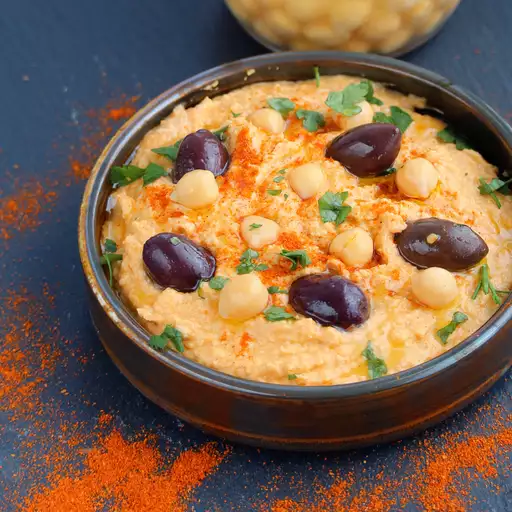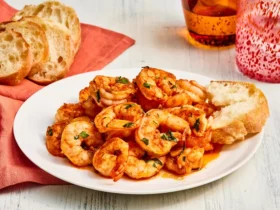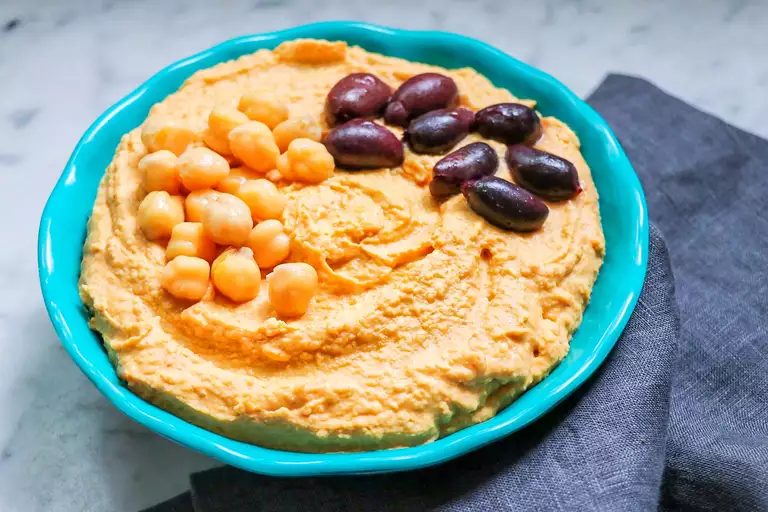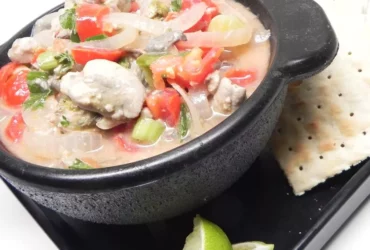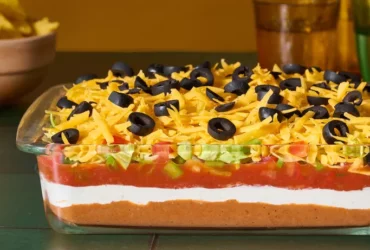Ingredients
A blend of chickpeas and spices
The ingredients for a classic harissa hummus recipe are as follows:
Main Ingredients:
- 1 cup of dried chickpeas, soaked overnight and drained
- 2 cloves of garlic, peeled and minced
- 1/4 cup of fresh parsley, chopped
- 1/4 cup of fresh cilantro, chopped
- 1/2 teaspoon of salt
Harissa Spice Blend:
- 2 teaspoons of harissa paste (North African chili pepper paste)
- 1 teaspoon of ground cumin
- 1/2 teaspoon of smoked paprika (optional)
- 1/4 teaspoon of cayenne pepper (optional)
Lemon Juice and Olive Oil:
- 2 tablespoons of freshly squeezed lemon juice
- 1/4 cup of extra virgin olive oil
Aromatics:
- 2 tablespoons of chopped fresh scallions, for garnish
- 1/4 teaspoon of sumac (optional, but recommended)
1 1/2 cups cooked chickpeas
- The chickpeas are a staple ingredient in this recipe, providing a creamy base for the Harissa Hummus.
- Canned chickpeas can be used as a substitute for cooked chickpeas, but cooking them from scratch yields better results in terms of texture and flavor.
- To cook chickpeas from scratch, simply soak 1 cup of dried chickpeas in water overnight, then boil them until they’re tender.
- After boiling the chickpeas, drain the water and rinse them with cold water to stop the cooking process.
- Once the chickpeas have cooled, you can use 1 1/2 cups of them as the base for the Harissa Hummus recipe.
- This quantity provides enough creaminess without overpowering the other flavors in the dish.
- The chickpeas’ mild taste makes them an ideal canvas for the bold, spicy flavor of Harissa that’s central to this recipe.
1/4 cup harissa paste
Harissa paste is a fundamental component of many North African and Middle Eastern dishes, particularly in those originating from Tunisia, where it originated. It’s made from roasted red peppers, garlic, coriander seeds, caraway seeds, olive oil, and salt. The ingredients are typically blended together and then crushed or ground to create the distinctive paste that is a staple condiment in many households.
Harissa paste has a fiery heat, courtesy of the presence of chili peppers in its ingredients list, although its level of spiciness can vary depending on how it’s prepared. While some recipes may use fresh red peppers, others rely on dried ones for an intense flavor and heat that is more concentrated. The addition of garlic adds to the depth of flavor in harissa paste.
Garlic itself plays a significant role in many cuisines around the world due to its pungency, health benefits, and versatility in cooking. When combined with chili peppers, it gives harissa its distinctive taste that is both spicy and aromatic, making it an essential ingredient in North African dishes such as couscous, meat stews, and vegetables.
In the context of a recipe like Harissa Hummus, harissa paste serves not just to add heat but also depth. It’s often combined with chickpeas, tahini, garlic, lemon juice, salt, and olive oil to create a creamy hummus that has both a spicy kick from the harissa and a rich nutty flavor from the tahini.
Given its spiciness level can vary significantly based on how it’s prepared, it’s common for people who prefer milder flavors to adjust their recipe accordingly. However, those who enjoy stronger tastes often appreciate using more of the harissa paste or making it themselves to have better control over the heat and flavor.
For a 1/4 cup serving in the Harissa Hummus Recipe, start by checking your harissa paste’s ingredients list for chili peppers as they contribute significantly to its spiciness. If you’re looking for an intense but not overwhelming flavor, aim for a slightly above-average heat level in your harissa.
1/4 cup freshly squeezed lemon juice
When it comes to making a delicious and spicy Harissa Hummus, using high-quality ingredients is crucial. One of the essential components is freshly squeezed lemon juice, which adds a bright and tangy flavor to the dip.
The recipe calls for 1/4 cup of freshly squeezed lemon juice, but what exactly does that mean? The term freshly squeezed implies that the lemon juice has been extracted from lemons using a manual or mechanical process, rather than being bottled or packaged. This means that the lemon juice is in its purest form and hasn’t been preserved with any additives or preservatives.
The lemon itself is an important ingredient to note. Lemons are a type of citrus fruit that are rich in vitamin C and have a unique flavor profile that’s both sour and slightly sweet. When choosing lemons for your Harissa Hummus, look for ones that are heavy for their size and have a bright yellow color. These signs indicate that the lemons are ripe and ready to use.
Now, when it comes to squeezing the lemon juice, you’ll want to use a manual or electric juicer to extract the liquid from the lemon pulp and membranes. Be sure to discard any seeds or pulp that are released during the process, as these can add bitterness to your hummus.
The amount of lemon juice called for in the recipe is 1/4 cup. You can adjust this amount to taste, but keep in mind that too much lemon juice can make your hummus overly acidic and overpowering. Start with a smaller amount and gradually add more to achieve the desired balance of flavors.
Some other key ingredients to note when making Harissa Hummus include:
chickpeas: These are the main ingredient in traditional hummus recipes, providing a rich source of protein and fiber.
harissa: This is a type of North African chili pepper paste that adds a spicy kick to your hummus. You can use store-bought or homemade harissa for this recipe.
garlic and ginger: These aromatic ingredients add depth and warmth to your hummus, making it perfect for snacking or serving as a side dish.
In conclusion, the use of high-quality ingredients like freshly squeezed lemon juice is essential when making delicious Harissa Hummus. By paying attention to the details and using the right ingredients, you’ll be able to create a tasty and authentic dip that’s sure to impress your friends and family!
1/4 cup tahini
Tahini is an essential ingredient in traditional Middle Eastern cuisine, particularly in dips and spreads like hummus. In the context of this Harissa Hummus Recipe, 1/4 cup of tahini is a crucial component that provides rich flavor and creamy texture. Tahini is made from ground sesame seeds and has a nutty, slightly sweet flavor profile.
The use of tahini in this recipe serves several purposes. Firstly, it helps to create a smooth and velvety consistency for the hummus, making it more palatable and enjoyable to eat. Secondly, its nutty flavor complements the spicy kick from the harissa, adding depth and complexity to the overall taste experience.
When choosing a tahini for this recipe, it’s essential to select a high-quality product that is free of additives and preservatives. Look for a brand that uses only roasted sesame seeds and has a rich, creamy texture. This will ensure that your hummus turns out with the perfect balance of flavors and textures.
In terms of measurements, 1/4 cup of tahini may seem like a relatively small amount compared to other ingredients in the recipe. However, its potency is such that it can make or break the flavor profile of the hummus. If you’re unsure about using this amount, start with a smaller quantity (such as 2 tablespoons) and adjust to taste.
Finally, keep in mind that tahini can be quite expensive, depending on the brand and quality you choose. However, its richness and depth of flavor make it an essential ingredient for any serious food enthusiast or chef. In this Harissa Hummus Recipe, 1/4 cup of tahini is a must-have to achieve the perfect balance of flavors.
Puree ingredients for a smooth consistency
To achieve a smooth consistency for the harissa hummus recipe, it’s essential to puree the ingredients properly. This involves using a high-quality blender or food processor that can handle tough ingredients and blend them into a silky texture.
Start by adding the chickpeas, lemon juice, garlic, salt, and tahini to the blender. These are the base ingredients for traditional hummus, but in this recipe, we’re adding harissa for an extra kick of heat and flavor. Make sure to add these ingredients in order, starting with the chickpeas and ending with the tahini, as each ingredient will affect the consistency and texture.
Next, slowly pour in the water while blending on high speed. This is crucial for achieving the right consistency. The water helps to break down the ingredients and create a smooth, creamy texture. Be careful not to add too much water, as this can lead to a thin, soggy hummus. Start with a small amount of water (about 1-2 tablespoons) and gradually add more as needed.
Now it’s time to add in the harissa paste. This is where the magic happens! Harissa adds a deep, spicy flavor that complements the chickpeas perfectly. Add a teaspoon or two (depending on your desired level of heat), and blend until well combined.
Finally, taste and adjust as needed. If you prefer a milder hummus, add more lemon juice or tahini. If you want it spicier, add more harissa. And if you’re feeling adventurous, try adding some chopped fresh herbs like parsley or cilantro for extra freshness.
The key to achieving a smooth consistency is patience and persistence. Blend the ingredients on high speed until they reach your desired texture. This can take several minutes, so don’t rush it! If you’re using a high-quality blender, you should end up with a silky, creamy hummus that’s perfect for dipping vegetables or pita bread.
2 cloves garlic, minced
In the Harissa Hummus recipe, two cloves of garlic are used to add a rich and savory flavor to the dip.
To prepare the garlic, it’s essential to mince it finely using a chef’s knife or a garlic press.
Here are the steps involved in mincing two cloves of garlic:
- Multiply 2 by 1.6 (the weight of one clove of garlic) to find the total weight of garlic needed
- Select two plump, firm cloves from a head of garlic
- Rinse each clove under cool running water, then gently pat them dry with paper towels to remove excess moisture
- Peel off the papery skin from the top of each clove, making sure not to crush or bruise them in the process
- Lay a clove on its side and locate the root end (the thicker end)
- Multiply the weight of one clove by 2 to find the total weight needed (1.62 = 3.2 grams)
- Using a sharp knife, make parallel cuts about 1/4 inch apart along the length of the clove
- Turn the clove and make perpendicular cuts across the slices, but do not cut all the way through the clove
- Now, holding the clove firmly in place with your non-knife hand, chop it into small pieces by carefully cutting through the slices you created earlier
- The goal is to achieve a mixture of fine and coarse particles to give the hummus a deep and aromatic flavor
- Gather the minced garlic into a bowl and mix well with lemon juice and other ingredients in the Harissa Hummus recipe.
- Adjust the amount of garlic according to your taste preferences, as some people prefer a stronger garlic flavor while others prefer it milder
The use of two cloves of garlic adds a depth and warmth to the Harissa Hummus that complements the spicy kick from the harissa pepper.
1/2 teaspoon salt
Salt plays a vital role in enhancing the flavor of dishes like hummus, and 1/2 teaspoon is often sufficient to bring out the natural flavors of the chickpeas without overpowering them.
When it comes to using salt in recipes like Harissa Hummus, the type of salt can also impact the overall taste. Some common types of salt include table salt, kosher salt, and sea salt, each with its own unique texture and flavor profile.
The most commonly used salt in cooking is table salt, which is often finer and has a purer sodium chloride composition than other types of salt. However, some chefs prefer to use kosher salt or flaky sea salt for their recipes because of the slightly different textures and flavors they impart.
In general, it’s best to use the type of salt that you have available in your pantry when following a recipe like Harissa Hummus. The key is to taste as you go and adjust the seasoning accordingly, rather than relying solely on specific measurements of salt.
The 1/2 teaspoon measurement for salt in this harissa hummus recipe should be taken as a rough guideline, rather than a hard-and-fast rule. Feel free to experiment with different amounts of salt to suit your taste preferences and create the perfect balance of flavors in your dish.
Tips and Variations
Add some heat or adjust flavor to taste
To take your Harissa Hummus recipe to the next level, consider these tips and variations that will add depth, heat, and excitement to this classic dip.
Tips
Add a squeeze of fresh lemon juice: A squeeze of fresh lemon juice can help brighten the flavors in your Harissa Hummus and bring out the natural sweetness of the chickpeas.
Use high-quality harissa: The quality of your harissa paste will greatly impact the flavor of your hummus. Look for a high-quality, roasted red pepper-based harissa for the best results.
Add some smokiness with paprika or smoked garlic: Smoked paprika or roasted garlic can add a rich, savory flavor to your Harissa Hummus and balance out the heat of the harissa.
Experiment with different types of chickpeas: While traditional chickpeas work well in this recipe, you can also try using canned or cooked garbanzo beans for a slightly different texture.
Variations
Spicy Harissa Hummus with Red Pepper Flakes
Add an extra kick to your hummus by mixing in some red pepper flakes or chopped fresh red chili peppers.
Creamy Harissa Hummus with Greek Yogurt
Mix in some Greek yogurt for a creamier, more indulgent version of the dip.
Roasted Beet Harissa Hummus
Roast some beets and then blend them into your hummus for a sweet and earthy twist on the classic recipe.
Mediterranean Harissa Hummus with Feta and Olives
Mix in some crumbled feta cheese, chopped Kalamata olives, and a sprinkle of sumac for a salty, savory dip that’s perfect for pita bread or crackers.
Remember, the beauty of this recipe is its versatility – feel free to experiment with different combinations of ingredients and flavors to create your own unique Harissa Hummus variations!
More harissa for extra spice
To take your Harissa Hummus to the next level, here are some tips and variations:
Tips
Adjust the heat level: If you prefer a milder harissa, start with 1-2 teaspoons of harissa paste. If you like it spicy, add up to 4 teaspoons or more to taste.
Add some freshness: Mix in some chopped fresh parsley or cilantro for a burst of freshness and flavor.
Roast the garlic: Mince 2-3 cloves of roasted garlic (see below) and add it to the hummus for a deep, rich flavor.
Variations
- Smoked Paprika Harissa Hummus: Add 1/4 teaspoon smoked paprika to give your harissa hummus a smoky depth of flavor.
- Middle Eastern-Style Hummus: Mix in 2 tablespoons of chopped fresh parsley and 2 cloves of minced garlic for an authentic Middle Eastern taste.
- Roasted Beet Harissa Hummus: Add 1 roasted beet, peeled and chopped, to give your hummus a vibrant pink color and earthy flavor.
- Lemon-Herb Harissa Hummus: Mix in 2 tablespoons of freshly squeezed lemon juice and 1 tablespoon of chopped fresh parsley for a bright, citrusy taste.
Roasting garlic is easy: simply cut the top off a whole head of garlic, drizzle with olive oil, wrap in foil, and roast at 400°F (200°C) for 30-40 minutes until soft and mashed. Squeeze the garlic out of its skin and use as desired.
Less lemon juice for a thicker consistency
To achieve the perfect consistency for your harissa hummus recipe, it’s essential to pay attention to the amount of lemon juice used. If you prefer a thicker and creamier dip, consider using less lemon juice in your mixture.
When making harissa hummus, start by blending together 1/4 cup of lemon juice with the chickpeas, garlic, tahini, water, salt, and spices. This will give you a good balance of flavors and textures.
If you want to reduce the acidity level in your recipe without compromising on the flavor, try reducing the amount of lemon juice by 1-2 tablespoons at a time until you reach the desired consistency.
Another way to achieve a thicker consistency is to add more chickpeas or tahini. This will not only thicken the hummus but also enhance its creaminess and nutty flavor.
Keep in mind that using less lemon juice may affect the overall flavor profile of your harissa hummus. You can always adjust the seasoning by adding more cumin, coriander, or chili flakes to balance out the flavors.
To take your harissa hummus recipe to the next level, try experimenting with different variations such as:
Adding roasted red peppers for a sweet and smoky flavor
Mixing in chopped fresh herbs like parsley or cilantro for added freshness
Using Greek yogurt instead of tahini for a tangy twist
Spicing up your hummus with diced jalapeños or serrano peppers for an extra kick
Experimenting with different types of chili peppers, such as Anaheim or guajillo, to change the heat level and flavor profile.
Remember, the key to making great harissa hummus is to experiment and find the combination that works best for you. Don’t be afraid to try new ingredients and flavor combinations to create a unique taste experience.
A pinch of cumin for added depth
When it comes to making a delicious and authentic Harissa Hummus, there are several tips and variations that can help you take your dip game to the next level.
Firstly, let’s talk about the importance of using high-quality ingredients, particularly when it comes to the cumin called for in this recipe. A pinch of cumin adds a depth of flavor that is essential to the North African and Middle Eastern cuisines that this hummus recipe draws inspiration from.
If you’re feeling adventurous, try adding some diced jalapeños or sliced hot peppers to give your Harissa Hummus an extra kick of heat. This is especially great if you’re serving the dip as a snack for a party or gathering, as it’s sure to be a conversation starter.
For a smoky twist on traditional hummus, try adding some roasted red peppers that have been pureed into the mix. This adds a sweet and slightly charred flavor that pairs perfectly with the spicy kick of the harissa.
If you prefer a creamier hummus, try adding some avocado oil or olive oil to help bring out the richness and depth of flavor in the dip. You can also add some sour cream or plain Greek yogurt to give it an extra tangy kick.
Finally, if you’re feeling really fancy, try serving your Harissa Hummus in a mason jar or small tapa bowl, garnished with some fresh herbs like parsley or cilantro and a sprinkle of cumin seeds. This makes for a beautiful and Instagram-worthy snack or appetizer that’s sure to impress your friends and family.
With these tips and variations, you’re well on your way to making the most delicious Harissa Hummus recipe out there. So go ahead, get creative, and enjoy!
Serving Suggestions
Pairs well with vegetables and pita bread
This delicious Harissa Hummus recipe is perfect for serving at any gathering or event, and it’s incredibly easy to pair with a variety of ingredients to enhance its flavor and texture.
One of the best ways to serve this harissa hummus is by pairing it with fresh vegetables. Carrot sticks, cucumber slices, cherry tomatoes, and bell pepper strips make great dippers for this spicy and creamy dip.
The smoky heat from the harissa pairs particularly well with crunchy and cool vegetables like cucumbers or carrots, creating a beautiful balance of flavors and textures in each bite.
You can also serve this harissa hummus with warm pita bread, which helps to temper the spiciness of the dip. The crispy texture of the pita chips provides a satisfying contrast to the smooth and creamy hummus.
For an added touch, try garnishing your serving of harissa hummus with some chopped fresh parsley or cilantro, adding a burst of fresh flavor to each spoonful.
This harissa hummus is also great as a spread for sandwiches or wraps. Simply pair it with sliced meats, cheeses, and vegetables for a delicious and filling meal on-the-go.
Cucumber slices or carrot sticks for snacking
Serving suggestions are a crucial aspect to consider when preparing and presenting dishes like Harissa Hummus, which is often served as an appetizer or snack.
Cucumber slices and carrot sticks are two popular choices for accompanying snacking to Harissa Hummus, particularly in casual gatherings and outdoor events where finger foods are a hit.
The refreshing crunch of the raw vegetables complements the rich flavors and spicy kick of the hummus perfectly.
To enhance the snacking experience, consider serving the cucumber slices and carrot sticks on a platter or tray with the Harissa Hummus at its center.
This visual presentation creates an inviting display that encourages guests to grab a snack and dig in.
For added convenience, you can also set up a build-your-own-snack station where guests can assemble their own carrot sticks, cucumber slices, or even pita chips with the Harissa Hummus.
This interactive approach not only adds fun but also caters to various tastes and dietary preferences, including those who may be gluten-free or have other allergies.
Ultimately, serving cucumber slices and carrot sticks alongside Harissa Hummus provides a well-rounded snacking experience that is both healthy and delicious, perfect for any occasion where finger foods are the star of the show.
Pita chips or warm pita bread for dipping
Serving Suggestions for Harissa Hummus:
- For a truly authentic experience, serve the harissa hummus with warm pita bread.
- This can be achieved by simply wrapping store-bought or homemade pita in foil and heating it in the oven at 350°F (180°C) for a few minutes.
- The warmth of the pita complements the spicy kick of the harissa, making each bite a delight.
- Alternatively, serve the hummus with pita chips for a crispy twist.
To make your own pita chips:
- Cut pita bread into triangles or strips
- Drizzle olive oil over the cut pita and toss to coat
- Sprinkle salt and any other desired seasonings (such as paprika or garlic powder)
- Bake in a preheated oven at 400°F (200°C) for 5-7 minutes, or until crispy
For a more substantial snack, consider serving the harissa hummus with:
- Cut vegetables such as carrots, cucumbers, and bell peppers
- Fried pita bread sticks (see above for pita chip recipe)
- Mixed greens salad with crumbled feta cheese and a drizzle of olive oil
- Grilled meats or kebabs for a more substantial meal
In any case, be sure to provide plenty of ice-cold water or lemonade to balance out the spiciness of the harissa.
- Best LeadsGorilla Alternatives for 2025 - April 22, 2025
- Best Leadzai Alternatives for 2025 - April 22, 2025
- Best LeadSwift Alternatives for 2025 - April 21, 2025

